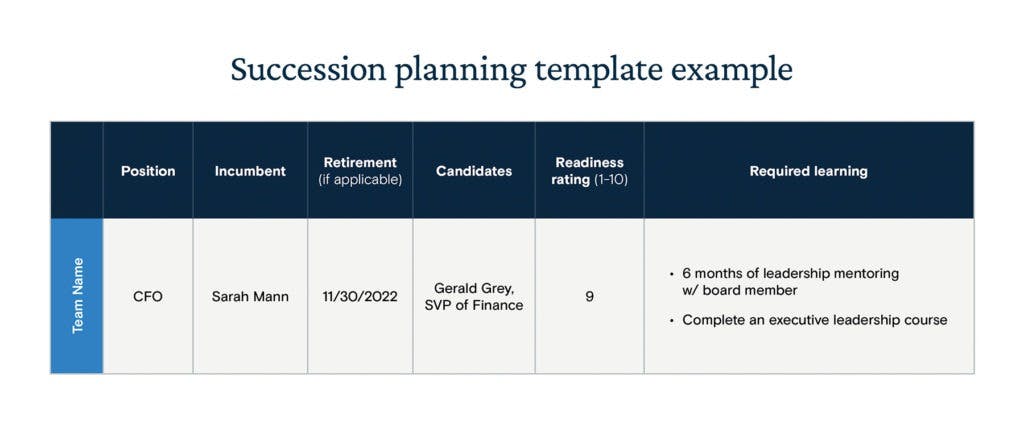Although many organizations understand the importance of succession planning, they often fail to prioritize it. This is because succession planning might seem time-consuming, with no immediate pay-off. The amount of perceived work required to develop a succession plan can derail even the most proactive of organizations.
However, when facing an unexpected vacancy, such as a sudden departure or retirement, a lack of proper planning for an adequate replacement can make a significant negative impact on your business. Understanding the critical roles within your organization and preparing potential successors who could step in when needed is well worth the time investment.
Getting a succession plan in place requires some heavy lifting on the front end. That’s why many HR professionals rely on tools, such as an easily replicable succession plan template, that can make the work far less arduous and a lot more manageable.
Let’s walk through the steps of developing a succession plan (or enhancing an existing one) and discuss how you can create a custom template to simplify and refine the planning process.
7 key steps to a successful succession plan
It can be tempting to dive right into a succession planning strategy – especially if you have an existing one in place – but the effectiveness of your strategy hinges on the amount of forethought and organization you put into its conception.
Here’s where to start.
1. Determine the type of succession plan you need
The exact details of your succession plan will depend on the unique positions within your business and how these roles might evolve based on the future needs of your company. Some questions to consider:
- Which potential talent losses pose a main concern to your company? Think beyond the C-suite.
- What is the typical lifespan of these key positions within your organization? Are there any common trends when you look at turnover rates across certain teams or job functions?
- Which positions are mission-critical and must be included? Are there other roles that are less critical on a daily basis, but might leave a deep hole in expertise, delay a long-term project or disrupt operations unnecessarily?
- In looking to future technologies or business priorities, how might the skills or requirements for your critical roles shift or expand? Are there existing skills gaps that you’re aware of?
2. Build a succession planning team
Succession planning is a company-wide need and a strategy that works for one department might not work for all. An effective approach requires leaders across all relevant business units within your organization to contribute.
For example, people managers that directly work with employees on goal-setting and professional development can be a huge asset during this process. They’re the ones that have insight into the individual’s skills and career goals. They can also help you to confirm a candidate’s interest in a role and outline the steps required for that individual to be potentially considered for the position.
Additionally, if learning and development (L&D) is outside of your wheelhouse, be sure to loop in those team members with knowledge about particular job competencies, career paths and related workforce development programs. Ultimately, a succession plan can’t be successful unless you have the resources in place to actually upskill and reskill workers in preparation for taking on a future position.
3. Align succession plan with organizational objectives
Your succession plan should not be seen as separate from your organizational goals, but as a tool for reaching them. For instance, if your company is prioritizing diversity, equity and inclusion (DEI), succession plans can help to identify and place underrepresented talent in a direct pipeline for leadership positions.
4. Create a succession plan template
Once you’ve completed the prep work, the next step is to focus on execution. Although succession planning looks different at every organization, it’s possible to create a template that’s custom to your business and easy to replicate each time you go through this exercise.
Succession planning template components
Your template should include the following fields:
- Positions: This can include executive, middle management and other roles you identify as critical.
- Incumbent: A profile on the current role-holder and any considerations unique to the individual and job position. If you’re planning for multiple roles at once, establish an urgency order.
- Candidates: Qualified and willing individuals with the potential to fill the incumbent’s role. You can also split this into two sections, one for candidates who are a good fit for the short-term (interim) and another section for candidates who possess the skills to be strong permanent replacements. Don’t limit yourself to a single candidate per role and try not to duplicate a particular candidate across multiple roles.
- Readiness rating: This is a score that you assign that indicates each candidate’s preparedness for the role in question. This might also include information about the skills, experience, degrees, credentials or other skill-building needed for the individual to be successful in the position.
- Timeline: Include one proposed timeline that addresses a long-term vacancy (retirement/death/unexpected resignation), and one addressing a short-term vacancy (parental leave or sabbatical).
Succession planning template example
Here’s an example of a constructed succession planning template:

5. Identify avenues for talent acquisition and development
Developing a succession plan is great, but you need a skilled talent pool of prospective candidates in order for it to truly have an impact. To do so, it’s important to have an idea of what channels are available to source candidates from. You may plan to nurture internal successors over the long run, but you should also be aware of which roles may necessitate looking externally.
You’ll also want to get a sense of what employee development opportunities are available for your workforce and ascertain if they’re aware of these programs and actually taking advantage of them.
It’s likely that many succession roles require specific training and education for a candidate to perform at a high level quickly. This is where it becomes critically important to collaborate with your L&D counterparts to understand the efficacy of your current programs.
6. Nurture talent for a strong succession plan
Once you’ve recorded your potential replacements, you can begin the process of cultivating these high-potential employees for the next step in their careers. Not only will they benefit from L&D for these specific roles, but your entire workforce can also up their performance and capabilities with long-term education opportunities, continuing to fill your talent pipeline in the process.
Scheduling regular time to review your succession plan will strengthen it perhaps more than any other exercise. Ask key questions such as:
- Are these potential candidates still relevant for the positions they’re slated to fill?
- Have you provided the training, support and education outlined in the template?
- Has it elevated their performance or readied them as you’d hoped? Or is more training and experience needed?
- Are other employees showing abilities ripe for growth and worth considering for the succession plan?
- Have any positions recently emerged as critical to the organization and relevant for the template?
7. Review, adjust and repeat
People leave organizations. This is a given — not if, but when — and without exception. By taking the time now to kick-start or refresh your succession plan, you are addressing these departures before they happen, avoiding the upheavals and inefficiencies that come with the vacancy of a critical role.
It’s important to reiterate the importance of reviewing your succession plan on an ongoing basis – a static succession plan fails to account for the ever-changing nature of your business.
Take a moment to evaluate whether any positions need to be added or removed from the template. Assess whether the candidates in your succession pool are taking sufficient initiative for their advancement — and if you’re giving them the appropriate support and learning opportunities to do so. Take a close look outside of the plan for other rising or capable employees. Keep your finger on the pulse of exceptional talent, be they internal or external and even those at junior levels.
With these best practices in mind, you can create a custom template for tracking high-potential candidates and filling your succession pipeline with skilled talent that’s primed and ready to step up.
It’s clear that skill-building is integral to the success of your succession planning efforts. Read our step-by-step guide to learn efficient, scalable ways to upskill and reskill your workforce for rapid results.


